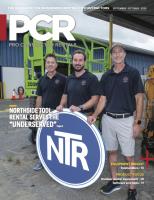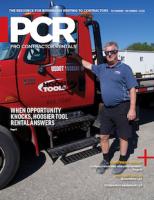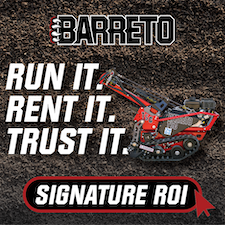Build Your Business: Embacing e-commerce
An e-commerce platform helps rental centers construct a competitive advantage.
by Jason Perez
There’s no question that change comes slowly in the equipment rental industry on both the contractor and the rental sides of the business. But like the hands of a clock that move so slowly you can’t actually see them move, change does come, albeit at a glacial pace.
Traditionally, technology is an area of change that the equipment rental industry has been most reluctant to embrace, especially on the actual rental process. For a number of reasons, rental companies continue to rely on direct phone ordering:
An insistence that human interaction is necessary for customer retention and satisfaction.
A fear of – or the cost of – technology tools and platforms that would allow e-commerce transactions.
A mentality of “this is the way we’ve always done it, and it works, so why change?”
Yet despite the protracted transition of the equipment rental market into the technological era, the transition is inevitable. According to the American Rental Association’s 2019 consumer survey, 34 percent of responding contractors already expect that their rental transactions will be done completely online. Sooner or later, technology gets its hooks into every industry; the rental industry is no different.
Human interaction will never become obsolete in the equipment rental industry. Many contractors who already have a strong personal connection with their supplier will likely be content to maintain the status quo, especially if they’ve been satisfied with the products and the services that their supplier has provided.
Still, there are new customers to consider. Many enjoy the digital experience and, even among existing customers, there is a percentage who would switch suppliers to gain access to the incredible convenience and efficiency that e-commerce sites offer.
The numbers certainly back up the effectiveness of the online experience, as well as the potential to attract new customers:
In 2018, United Rental’s digital commerce across all channels attracted over 30,000 net new customers, resulting in a 45 percent increase in digitally generated revenue year-over-year.
Since Sunbelt Rentals launched its new responsive website, its online leads increased by 350 percent, online equipment rentals increased by 200 percent, and overall user experience online improved dramatically.
Grainger expects that 80 percent of its revenue will come from e-commerce by 2023.
There are a plethora of reasons why this transition is finally occurring and picking up steam. But there are several that have played the most significant roles:
The Millennial Factor: In 2016, millennials (25 to 40 years of age) became the largest generation in the United States labor force. Today, this group accounts for more than one-third of the entire labor force in the United States. Further, according to a study conducted by Merit Marketing, up to 73 percent of all B2B buyers are now millennials. Regardless of industry, this is a population group that does a large percentage of its business online.
Answer the Easy Questions: New rental customers may very well want to speak with a salesperson on the phone for their first transaction. But assuming they become repeat customers, they are going to ask questions that can be easily answered through a well-constructed e-commerce site. Calling to ask if an order has been processed or whether a specific piece of equipment is available is a waste of time for the contractor and the supplier.
“Just Like Amazon”: According to the GearFlow Blog, B2B buyers expect more of an “Amazon-like” experience. “Our ability to order products online and via apps, such as Amazon, our customer base demands a similar ordering experience,” the blog notes. What’s more, prior to talking to a salesperson, new equipment renters will often examine the supplier’s website, read online reviews and conduct additional online research activities. Doing so allows them to get a more detailed picture of the supplier’s business before they pick up the phone. This all requires that the company have a well-designed, comprehensive, and easily navigable e-commerce website.
They Want It When They Want It: This point was driven home by Dale Asplund, COO of United Rentals during the keynote presentation of ARA’s RentalTech conference.
“In today’s world, customers expect to do business when they want to do business, having a system … that gives them access 24/7 when they want to get the support,” Asplund says. “The days of sitting at a rental counter will soon be behind us.”
These facts have established why a high-quality e-commerce site is critical for equipment suppliers, perhaps it’s time to address how to construct one. Frankly, for rental companies that aren’t United Rentals, an e-commerce site may be out of reach. Utilizing the services of an outside resource is not going to be cheap and most rental companies don’t have the internal personnel to take on such a daunting assignment.
The good news is you don’t have to do it all at once. There are ways to complete some of the steps with less expense than you might expect. The key: take baby steps. There are additional steps to take after performing the ones below that will help you continue to improve your site; the ones listed here will help get you into the e-commerce game.
Website comes first
There are several software tools on the market that will allow you to create an efficient, visually interesting site on your own. If you prefer to have someone else handle it, there are a vast array of freelance designers and programmers who can do the job at a very reasonable price.
Product catalog, Part I
You may already have a print version, but an online product catalog is a must. This can be a time-consuming project and will probably be one of the pricier items.
Product catalog, Part II
In Part I, renting a piece of equipment will be a manual process (i.e., filling out a form after which a sales rep will call you); part II involves automating the form. This means everything: the ordering; figuring the price including the taxes; emailing receipts; the works. It also means having a way of accepting payments – credit cards, and possibly Venmo. You can also use one of several effective construction equipment rental software programs.
The portal
A website that allows customers to order equipment and pay for it automatically is a great beginning; a real e-commerce site allows the customer to do so much more: check order status, see past orders, cancel orders and allocate equipment. As technology has progressed, the benchmark for what constitutes a high-quality rental supplier has become much more demanding. Now you’ most give them tools to run their business and access data in a simple fashion, not just rent equipment.
Within the rental industry, the capability to build out an exceptional supplier portal has only been attainable for the top rental companies with significant capital and technical resources. However, Yardz offers RentaLynx, which allows rental companies to spend a fraction of that to attract a first-class customer, allowing the supplier to effectively elevate its customer experience to that of a much larger rental company.
Content is king
Your website might look great coming out of the gate, but if you don’t add new content to it on a regular basis, it’s going to get as stale as day-old bread. Continually adding new content to your site achieves a number of objectives:
- It assists with search engine optimization (SEO) efforts so you can be found through online searches.
- It improves “stickiness” – it keeps customers and prospects on your site for longer periods.
- It helps educate, inform and even entertain your customer, giving them a better online experience.
The types of content a rental center can add to keep its site vibrant are endless; certainly, items about your company and its products, but also news about industry trends, how-to articles, even a weekly or bi-weekly blog.
Having a great e-commerce site without an SEO program is like getting all dressed up and having no place to go. At some point, working with a specialist in search engine optimization is going to be necessary to help prospects find your site and see for themselves just how functional, useful and visually interesting it is. The best SEO programs are ongoing: having someone perform a one-time assignment will certainly help in the short-term, but because the major search engines regularly change their search algorithms, a consistent program is the only way to keep at the top of the search results.
There’s been a tremendous shift in terms of what contractors’ expectations are within the industry and what a rental company should look like. Most rental companies believe good service is enough, and that means showing up on time and delivering equipment. You still need several that; that’s foundational. But a true e-commerce site, complete with a customer portal, is the surest way to give your renters the online experience that they are increasingly expecting.
It’s not just about getting new customers; sales reps should focus their efforts on converting new business, rather than spending time handling transactions that will happen anyway or answering questions that the site can handle without human involvement.
An e-commerce site will help you check all the right boxes: gain new customers, keep existing customers, free up internal resources and generate more business. Start collecting your resources and begin construction. <
Jason Perez is the CEO of YARDZ, a platform that serves in the construction industry for management of rented and owned assets.
This article originally appeared in the January-February 2022 issue of Pro Contractor Rentals magazine. ©2022 Urbain Communicaitons LLC. All rights reserved.










